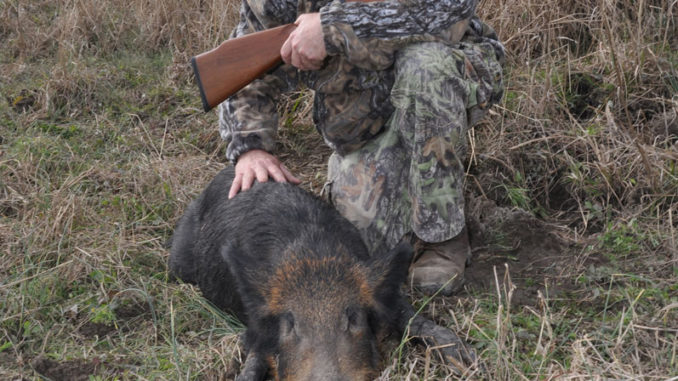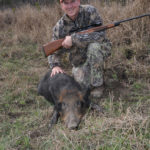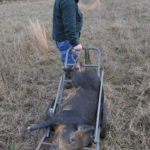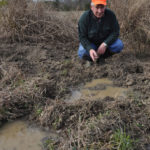
Two big chunks of public land along the Waccamaw and Pee Dee rivers offer hunters great hog-hunting opportunities.
Basil Watts hauled a deer cart from the bed of his pickup truck. Unhooking the elastic cords holding it together, he unfolded it to deploy the wheels.
“Next to my antique Marlin .45-70 lever-action, my game cart is the most important piece of equipment I have for hunting hogs on public land,” said Watts, a retired Cape Fear River pilot from Southport, N.C., who spends as much time hunting as possible. “As soon as deer season ends, I look for a place to hunt hogs.”
Watts was returning to the woods to retrieve a 200-pound sow he killed on the Waccamaw Heritage Preserve WMA in Horry County. Watts had seen a sounder of 20 sows and their young.
“I could probably have shot another one,” he said, “but one hog at a time is more than enough to carry out of a swamp. Getting the hog home and skinning and butchering it will take all afternoon.”
Watts said the most important thing to keep in mind when hunting for a place to hunt hogs is that they move around. The same pigs may be near the river one day then move miles to a field or other high spot overnight. A good hunting spot last year may be devoid of hogs this year.
“I started hunting Waccamaw National Wildlife Refuge last year,” he said. “The special still-hunting season for hogs at the Waccamaw Heritage Preserve WMA only runs one week, so I had to find another spot to hunt to have more days. Special spring hogs hunts have become more uniform from one WMA to another, but the still-hunts got shorter and I don’t hound-hunt.”
Another piece of equipment Watts plans to add to his arsenal is a boat, because the. Pee Dee and Waccamaw rivers flood in spring, pushing hogs to islands.
Craig Sasser, refuge manager at Waccamaw National Wildlife Refuge, said the special March hog-hunting season aims to control the non-native species. Sasser has been at Waccamaw NWR since planning began in 1994 before the refuge opened in 1997.
“Almost all of the refuge has hogs, but they are they are mostly in wetland areas,” Sasser said. “We manage them because of habitat loss and to reduce the impacts on farmers around the refuge. If we could, we would eliminate them, but they are resilient animals. The more hunting pressure we put on them, the more difficult they are to hunt. We encourage hunters to take hogs during our deer hunts, as well as during the hog-hunting season.”
The refuge’s hog-hunting season runs between small-game and turkey seasons to avoid conflicts as well as to give hunters another opportunity. Special rules apply, including allowing hunting only from elevated stands.
“The No. 1 objective is safety,” he said. “We don’t want people walking around, stalking on foot or hunting from boats. Shooting high-powered rifles on a level plane is not a good thing with other people potentially in the woods.”
The main problem with hunting hogs in both hunting areas is water. However, water is also a key to success.
“The Pee Dee and Waccamaw rivers are subject to flood during the spring,” he said. “For those who know the rivers and high spots, hog hunts can be pretty productive. Hogs get out of the water to stay warm. They leave Bull Island when it floods and head to Sandy Island. The high spots at Sandy Island can concentrate them, making them easier to hunt. There are 13 ramps spread out in the refuge areas. It is difficult for us to keep records of all the hogs that hunters harvest because we do not require reporting. But people are doing well from Sandy Island south in Unit 3. Still, you might encounter hogs that have migrated up the rivers along the bottoms.”
In Unit 3, hunters can time the tides to advantage because the daily range is 3 to 4 feet. In Units 2 and 3, however, only floodwaters move hogs.
“Unit 3 has some private waterfowl impoundments around,” he said. “When the impoundments are flooded, the hogs go into the refuge so those areas can be really productive. However, everyone is working hard to reduce hogs in that area, so Unit 2 may be a better bet, especially on the Waccamaw River side.”
A good place accessible by road is Jackson Bluff. However, that has been a focal area for hog reduction.
“We have done some trapping there, so hog numbers are down,” he said. Most hunters take boars, though, and boars don’t go into our traps.”
DESTINATION INFORMATION
HOW TO GET THERE — To reach the Waccamaw River National Wildlife Refuge, take US 501 south out of Conway to Yauhannah; the refuge office and visitor center are on the left after you cross the Pee Dee River. Best access by boat is from the Enterprise Landing off SC 926, the Peachtree Landing off SC 611, and the Bucksville Landing and Toddville Landing off US 701. The Waccamaw River Heritage Preserve WMA is in scattered tracts on both sides of the Waccamaw River from the North Carolina line south. Head north on SC 9 from the Grand Strand. Best access by boat is from Red Bluff Landing on SC 31 and Chris Anderson Landing on SC 9.
WHEN TO GO — Hog hunting is in season through the entire month of March, except on Sundays. Waccamaw Heritage Preserve WMA has a special still-hunting season for hogs March 2-7 and a hound-hunting season, March 9-14.
BEST TECHNIQUES — Hunting from an elevated stand is the best way to still-hunt hogs. Hunters should look for signs of recent hog activity and set up their stands downwind. As far as weaponry, buckshot and rimfire rifles are not allowed for hog-hunting on Waccamaw NWR. Buckshot is prohibited for still-hunting hogs at Waccamaw HP WMA and hound-hunters are restricted to pistols only. Still-hunters should use the same rifles that they use for hunting deer.
MORE INFORMATION — Waccamaw National Wildlife Refuge, Georgetown, 843-527- 8069, http://southeast.fws.gov/Waccamaw for hog-hunting season and regulations.
ACCOMMODATIONS — Sleep Inn, Conway, 843-365-2828; Sleep Inn, Little River, 843-249-4848.
MAPS — S.C. Department of Natural Resources, www.dnr.sc.gov/wma/maps/WMAMap8.pdf. All hunting at Waccamaw NWR requires a signed permit that has maps and it is available at the refuge office. DeLorme South Carolina Atlas and Gazetteer, 800-452-5931 or www.delorme.com.








Be the first to comment